All-in-one version
Director's Message

Tony Tavares
From late December through March, a relentless series of deadly storms hammered the state with an unyielding force, causing flooding, mudslides, rockslides, downed trees, highway closures and evacuations. The destruction was overwhelming – but not intimidating.
The tremendous challenge of the winter storms brought out the best of our Caltrans road and emergency crews.
The bell rang for 2,500 employees and 314 of our road crews to respond to the mighty challenge. In a time that required one of our greatest and boldest efforts, Caltrans Road crews bravely overcame the storms’ brutal elements to safely restore order on our roads and highways.
Here’s a snapshot of what was accomplished.
- On U.S. Highway 50, just east of Kyburz in the Sierra, a Caltrans explosives team helped clear the highway of several large boulders that brought traffic to a halt.
- On State Route 1 near Santa Cruz, our teams were successful in re-opening a stretch of highway that had been marred by fallen trees and other debris beneath the bridge over the San Lorenzo River.
- Our District 10 crews answered the call after a rockslide on State Route 140 in Mariposa County near Yosemite Park forced a highway closure. Cleanup work continued through March, after which a one-lane opening was planned for two weeks before an anticipated full reopening.
- District 5 crews reopened State Route 154 from Santa Ynez Valley to Santa Barbara. Our crews cleared rockfalls and mudslides from the roadway, fixed drainage and conducted slope assessments for safety.
- Massive flooding had a major impact on a stretch of State Route 99 in San Joaquin County near Lodi. Our road crews worked tirelessly to reopen one northbound lane of the highway.
- District 4 emergency crews went right to work in response to a sinkhole on State Route 92 in Half Moon Bay in San Mateo County, implementing two-way traffic control while doing their outstanding work on repairing the sinkhole.
- In March, District 9 crews confronted flooding and related debris that forced the temporary closure of U.S. Highway 395 from Pearsonville (just north of Ridgecrest) all the way up to Lone Pine along the eastern Sierra. Elsewhere in the district, snow-removal operations were in full force for most of the winter amid record-breaking snowfall.
- District 3’s roadway-clearing crews worked long hours under challenging conditions in maintaining two vital commercial and tourism routes over the Sierra Nevada range: Interstate 80 and U.S. Highway 50.
The safety precautions our crews took in the face of the storms only reinforces our strong commitment to safety as Caltrans’ number one priority.
The storms proved to be a true test for our Safe Systems Approach, Move Over Safety Campaign, Be Work Zone Alert, our 28 Proven Safety Countermeasures and Road Safety Action Plan – just to name a few.

We realize there will always be risks. On average, about 12 people lose their lives daily on California’s roadways, with nearly four of those deaths occurring on our state highway system.
There is only one number I find that is acceptable when it comes to fatalities and injuries: zero.
Moving toward zero deaths is why I remain resolute in our quest to eliminate fatalities and serious injuries on all California roadways by 2050.
Our commitment will never waver. Our road crews are a testament to that.
From the tip of the Oregon border to the rural areas of the Central Valley, the rugged California coastline all the way to regions throughout southern California, Caltrans work crews found a way to counter the unforgiving effect of these storms.
As it turned out, Mother Nature’s wrath was no match for the resilience and spirit of our road crews – qualities that only bring out the best of who we are. Our next big challenge could very well be flooding that might result from the season's above-average rain and snowfall. We stand ready to work with and support affected communities in the coming months.
![]()
Caltrans goes the distance on ‘middle-mile’ broadband
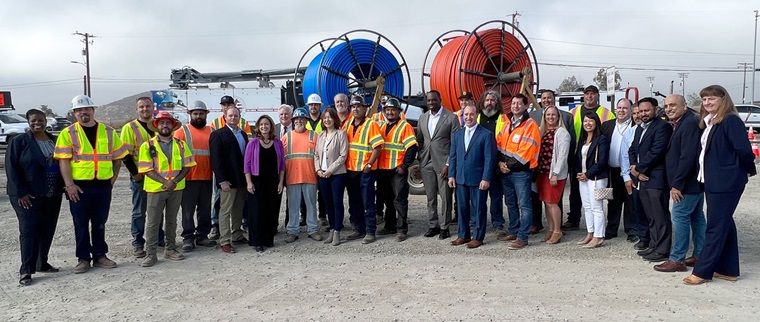
The $3.25 billion project’s goal is to give all Californians equitable web access
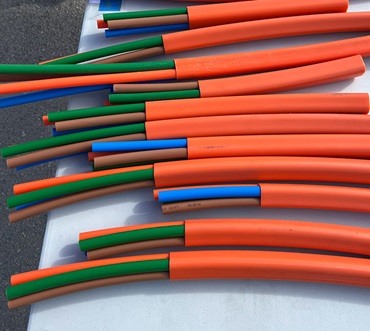
Recognizing that broadband is essential infrastructure, California has made a historic multi-billion-dollar investment that takes a comprehensive and long-term approach to tackling the digital divide.
Signed into law by Governor Gavin Newsom in July 2021, Senate Bill 156 seeks to expand the state’s broadband fiber infrastructure and increase internet connectivity for families and businesses. Caltrans is playing a critical role in the effort to strengthen all Californians access to reliable and affordable broadband service through the Middle-Mile Broadband Initiative.
The department is working with the California Department of Technology (CDT), the project leader, to manage construction of “middle-mile” broadband infrastructure along state highways within rights of way. This includes conduit, fiber optic cable, junction boxes and supporting elements) within the state right-of-way.
The Middle-Mile Broadband Initiative signed by Newsom aims to build the necessary infrastructure to create 10,000 miles of an open access, high-capacity network of fiber lines that carry large amounts of data at higher speeds over longer distances throughout the state. The $3.25 billion project will connect to a “last-mile” broadband infrastructure that tie homes and businesses to local networks.
The goal of this middle-mile network is to close the "digital divide" by providing reliable access to high-speed broadband service and prioritize inclusion of unserved and underserved populations, major institutions (hospitals, universities, government entities and community nonprofits), tribal entities, and agricultural regions.
Once fully constructed, the middle-mile broadband network will serve as the backbone infrastructure for last-mile providers to bring high speed internet to as many Californians as possible.
With funding through the federal American Rescue Plan Act, the projects covering the 10,000 mile network not only need to be complete but also have all funds used by December 2026. This is an aggressive timeline and a substantial amount of work.
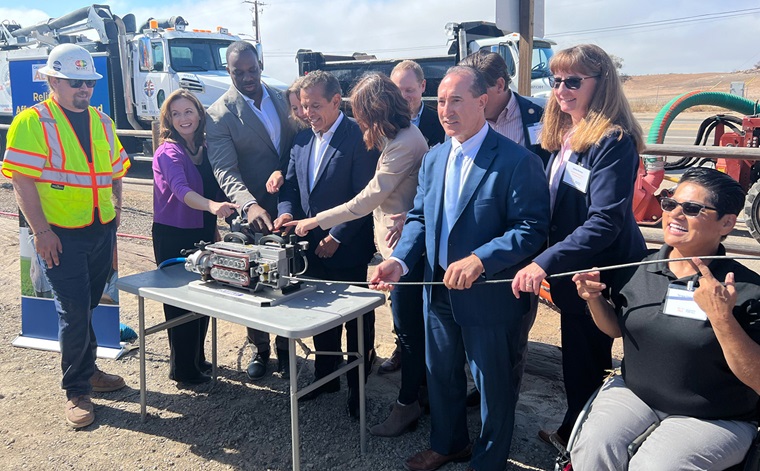
Caltrans is leveraging its decades of expertise in successfully delivering highway projects to meet the goals and purpose of the Middle-Mile Broadband Initiative. Given the tight timeline, Caltrans is using the innovative delivery methods – Job Order Contracting (JOC) and Construction Manager/General Contractor (CMGC) – to deliver the Middle-Mile Broadband Network projects.
Construction contracts for more than 70 percent of the network miles have already been advertised. This includes five regional JOC master agreements for more than 5,200 miles, 11 contracts that use the CMGC delivery method for approximately 1,900 miles, and Caltrans is working to advertise the remaining network miles this spring. Caltrans, which is partnering with the California Black Chamber of Commerce, has also advocated for small and disabled veteran businesses to ensure they are included in these opportunities.
To accomplish the Middle-Mile Broadband Initiative, Caltrans is using opportunities with this type of work to streamline its project delivery process to reduce timelines in design, permitting, and contracting, which allows much of these pre-construction processes to be completed concurrently. This is critical given the challenge of the finite deadline the federal government established for the funds.
Throughout the decades, Caltrans has been tasked with meeting a host of initiatives – SB 1, Clean California, and emergency response, among numerous others. With each initiative, Caltrans adapted and innovated to meet the unique challenge of each situation regardless of whether that entailed creating new processes and approaches or refining and streamlining existing procedures.
An online map of the 10,000 mile proposed build for the Middle-Mile Broadband Network can be found here.
Source: Caltrans Division of Design
![]()
State looks to make it easier for riders to take transit

The California Integrated Travel Project streamlines fares, transfers, schedules
When people choose public transportation over driving a personal vehicle, they make a positive difference in terms of traffic congestion and our environment. Traveling by bus, light-rail or other forms of public transit, however, requires one to navigate a sometimes-intimidating thicket of ticket prices, agency-specific fare cards and schedules that are sometimes still only on paper.
When public transportation systems impose conditions such as exact change and transfer tickets or separate fees, and planning your trip requires cumbersome research – as well as the possibility of delays – it’s easy to see how would-be riders throw up their hands and grab the car keys, for those who have cars.
The state of California is addressing these obstacles and improving the current mobility system with the California Integrated Travel Project (Cal-ITP). Caltrans and the California State Transportation Agency (CalSTA) are working with public transportation agencies to implement a system that makes paying for a transit ride as easy as buying a cup of coffee. CalSTA has allocated more than $27 million to the project since pre-planning began in 2018.
As is pointed out on the Cal-ITP webpage, California residents and visitors currently face a fragmented public transportation network that is often not user-friendly, costly to operate and faces new competition for ridership in many places. The burdens associated with taking transit often are concentrated in lower-income communities whose residents are especially dependent on public transportation.
According to Mobility Payments, a Reno, Nevada-based website that chronicles the issue, “the 300-plus transit agencies in California in 2019 recorded over 1.2 billion unlinked passenger trips and collected around $1.8 billion in fare revenue across transportation modes.”
The burdens associated with taking transit often are concentrated in lower-income communities whose residents are especially dependent on public transportation.
The goal of Cal-ITP is to move public transit payments to the retail system (payment by bank cards) in which riders can easily pay for transit just like they pay for everything else. And Cal-ITP provides technical assistance to transit agencies so they can more easily make the transition.
More broadly, Cal-ITP aims to:
- Ensure access to reliable and accurate transit information in real time.
- Reduce and eventually eliminate hassles in payments.
- Create a statewide eligibility verification program for customers who receive discounts on their travel so they don’t have to register with each and every transit or paratransit service they use.
- Ideally be able to provide users with one receipt at the end of the day for all transit transactions that occurred that day.
- Use the California Eligibility Verification program as a national model that could scale through partnerships with GSA and the Federal Transit Administration (FTA).
Demonstrations of Cal-ITP were completed by Monterey-Salinas Transit, Sacramento Regional Transit, Santa Barbara Metropolitan Transit, the Santa Barbara County-funded Clean Air Express and FACT (Facilitating Coordinated Access to Coordinated Transportation) in San Diego County.
In recent years, Caltrans and the other Cal-ITP coordinating agencies conducted four “Market Soundings,” which gather input from private, local and regional public agencies regarding their capabilities and interest in addressing the inadequacies of paying for government services and related digital aspects of getting around. The soundings, whose findings are linked to on Cal-ITP's and CDT’s Digital Identity Project webpages, are being used to help Cal-ITP and CDT reach their objectives.
Cal-ITP’s webpage lists a sampling of what the project is intended to do, and cites success stories from transit providers around the world. For example, Cal-ITP seeks to:
- Improve the customer experience, pointing out that contactless payments begun a few years go in New York City have been tried by people from 130 countries.
- Increase the use of contactless payment in transit, which according to Cal-ITP demonstration partner Visa increased by 187 percent from April to June 2020.
- Lower costs for transit providers and riders, reporting that the principal Washington, D.C., transit agency spends 10 cents per dollar collecting cash fares but only 4 cents per dollar on fares collected through credit/debit card.
Another component of Cal-ITP is helping transit providers remove the guesswork for riders wondering when the next bus or train will arrive or if they will make their connection. By coaxing transit agencies to comply with the General Transit Feed Specification (GTFS), the global standard for publishing transit information, transit agencies can get their services “on” Google Maps and Apple Maps for free. Caltrans developed minimum GTFS guidelines to help transit agencies achieve compliance.
Widespread acceptance of GTFS vastly improves trip-planning services, and allows transit and other modes to be represented on Google maps and Apple maps as real alternatives to planning a car trip. Standardized trip information is not only useful for customers, but also for operations planning and infrastructure investment by Caltrans, CalSTA, the California Air Resources Board (CARB) and California Environmental Council (CEC), as well as compliance reporting. For instance, CARB included Cal-ITP in its budget to align CARB’s incentives to outcomes. The California Transportation Commission (CTC) included GTFS data as a performance measure in its Trade Corridor Enhancement Program.
Finally, Cal-ITP helps transit agencies access the goods and services they need to modernize to standards by putting up a mobility store, camobilitymarketplace.org, where transit agencies nationwide can find FTA-compliant contracts negotiated by the California Department of General Services (DGS).
For example, transit agencies can find point of sale terminals for transit, inexpensive data connectivity plans and software that runs point of sale terminals for transit. DGS opened these contracts nationwide, so any local agency in the country can use the contracts without further competitive bidding. These contracts are already in use in South Carolina, at CoastRTA, and with other agencies in other states working their way through the process.
Sources: Gillian Gillett, Program Manager, California Integrated Mobility; Cal-ITP; CDT Digital Identity Project; CTC Cycle 3 guidelines
![]()
In Humboldt County, new bridge gives wildlife safer passage

70-foot-long span near Orick makes Highway 101 less perilous for all
Caltrans recently completed a fish passage improvement project at Little Lost Man Creek along U.S. Highway 101 north of Orick in Humboldt County, which replaced an existing box-shaped culvert with a full-span, 70-foot-long bridge. The project reaffirms Caltrans’ commitment to environmental preservation and restoration as part of its stewardship of the state highway system, one of the tenets of the department’s 2020-2024 Strategic Plan.
Little Lost Man Creek is a tributary of Prairie Creek and flows through a lush, old-growth redwood forest with some of the tallest trees in the world and a vast array of plant species and abundant wildlife within Redwood National and State Parks. The U.S. 101 crossing of Little Lost Man Creek is about 450 feet upstream of its confluence with Prairie Creek. About three miles downstream, Prairie Creek drains into Redwood Creek, about six miles from the Pacific Ocean. The watershed lies within the ancestral lands of the Yurok Tribal People.
The Little Lost Man Creek Bridge, within the boundaries of Caltrans regional District 1, was built specifically to help area fish and wildlife make their life cycle journeys. Prior to the project, software modeling showed that adult fish were only able to pass through the old culvert under U.S. 101 only 5 percent of the time during passable flows, while the path for juvenile fish was completely blocked due to water velocity and water depth constraints.
The project area was eventually designated by Caltrans as a high-priority fish passage barrier. Project planners came up with a design that simulated the adjacent channel to restore the stream after the new bridge was constructed, and bio-stabilization techniques were used to protect the stream banks.

Project staff also minimized harm to fish by relocating them immediately prior to construction.
Revegetation included the addition of red alder, lady fern, cascara, cow parsnip, Douglas iris, sword fern, thimbleberry, salmonberry, Sitka willow, and red elderberry.
Caltrans initiated the Little Lost Man Creek project in 2016, drawing design plans and securing permits over the next several years before awarding a contract for the work in 2019. Construction was completed in 2020.
The improved passage now allows fish and amphibious species to access approximately 1.2 miles of upstream habitat, opening up more spawning territory for Chinook and coho salmon, and steelhead trout that travel between ocean and fresh water.
Although it’s called a fish passage, the project benefits more than just those species. The restored creek section underneath the new Little Lost Man Creek Bridge offers a more conducive travel corridor for species that include lamprey, frogs, salamanders, foxes, raccoons, river otters, fishers, martens, deer and black bears.
Other benefits also accrue from the project. Because the new passage allows for more consistent, natural flows, Caltrans’ Maintenance crews no longer have to clear piles of woody debris that built up at the old box culvert.
The project also provided Caltrans with an opportunity to partner with the Yurok Tribe, which was supportive during project planning.
District 1 has completed six fish passage projects in the last few years. Another seven passage projects are currently in the works, including two projects on U.S.199 that are scheduled to begin this summer.
Caltrans works to improve fish passages throughout the state by coordinating and partnering through Fish Passage Advisory Committees, which include staff from the California Department of Fish and Wildlife, the National Marine Fisheries Service and other remediation partners.
In 2020, the most recent year that statistics are available, Caltrans completed fish passage remediation projects at four barrier locations in the state, improving access to an estimated 124 miles of salmon and steelhead trout habitat. Caltrans is currently developing projects to remediate 28 fish passage barriers, which would improve access to 186 miles of currently blocked salmon and steelhead trout habitat.
The Little Lost Man Project was funded with $2 million from the Caltrans Bridge Rehabilitation and Replacement State Highway Operation and Protection Program (SHOPP) and received an additional $5.4 million in construction funding through Senate Bill 1.
Source: Myles Cochrane, Caltrans District 1 public information officer
Dominie Creek also outfitted with new fish passage
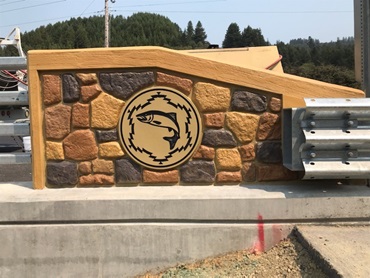
And another one! Caltrans also recently completed a fish passage improvement project at Dominie Creek along U.S. 101 in the Smith River area of Del Norte County. It replaced a box culvert with a full-span bridge, remediating a fish passage barrier, and providing unimpeded access for salmonids to approximately 1.6 miles of upstream habitat.
Additionally, 200 feet of concrete that lined the channel upstream was removed and replaced with streambed material embedded with willow stakes that will improve stream conditions by providing cover, shade, and food for the fish. Another 340 feet of stream channel was reconstructed to restore the channel below the bridge.
Caltrans, a contracted biologist, and the California Department of Fish and Wildlife worked together to relocate fish during construction activities. Species relocated include young-of-the-year trout, cutthroat trout, chinook, coastal giant salamanders, as well as red-legged and red-tailed frogs.
The design on the bridge abutments was created completely by a Tolowa Dee-ni’ Nation member as staff worked with the Federal Highway Administration (FHWA) to match it with the bridge’s color palette and nearby signage. This project served as mitigation related to Caltrans’ upcoming Dr. Fine Bridge Replacement on U.S. 101 near Smith River in Del Norte County.
Source: Myles Cochrane, Caltrans District 1 public information officer
![]()
Statewide pilot models quick safety improvements

Roadways enhanced with more warning signs, crosswalks, other features
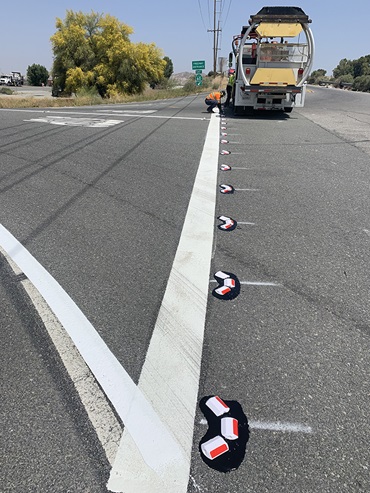
Thousands of California off-ramps, intersections, and highways will see safety enhancements sooner thanks to an innovative effort that is expediting safety projects throughout the state.
The HM-4 Safety Pilot Program (“HM” short for highway maintenance), the result of a collaboration among Caltrans’ districts, the Maintenance Division, and the Division of Safety Programs, was launched in 2021 to deliver cost-effective safety projects through Highway Maintenance. The first fiscal year of the two-year program ended in June 2022.
So far, the program has expedited funding for horizontal curve warning sign packages, crosswalk enhancements, and wrong-way driver prevention countermeasures at about 4,500 spot locations statewide.
“This program allows us to quickly initiate and complete enhancements that are lower cost but highly effective in terms of saving lives,” Chief Safety Officer Rachel Carpenter said. “This is a great example of a proactive, collaborative program that is helping Caltrans to achieve our goal of zero fatal and serious injury crashes on our system.”
Background
In July 2021, the HM-4 Safety Pilot Program was approved with a budget of $21.6 million per year. The Division of Maintenance manages this program in collaboration with the Division of Safety Programs.
The program created a funding source to quickly implement Proven Safety Countermeasures (PSCs) through the HM Program delivery cycle. It funds capital costs for stand-alone projects in three areas: Wrong-Way Driver Prevention Countermeasures, Horizontal Alignment Curve Warning Sign Packages, and Pedestrian Safety Improvements. The last area is critical as a disproportionate percentage of fatal crashes involve pedestrians (about 20 percent on the State Highway System, and about 30 percent on local streets and roads).
HM projects tend to be shorter-lead, quick-build projects with limited right of way or permitting delays, so they can be programmed and constructed much faster than traditional project development methods. Safety enhancements developed through the HM programs generally can be installed within a year or two; these same improvements would otherwise be stand-alone safety capital projects, or part of other capital projects that can take several years to initiate.
To develop and manage this program, Caltrans created limited-term positions in Headquarters Safety Programs and Maintenance Divisions. The program coordinators reached out to all districts for project nominations in the three focus areas. Headquarters and district project engineers and pedestrian coordinators reviewed and prioritized the project nominations to finalize work plans.
Maintenance added selected projects to its HM Contract for Delivery for the participating districts. The Maintenance Division tracks delivery and completion of each approved project. Safety Programs is tracking and documenting the performance measures (spot location quantities) for each approved project.
Results
In the first two fiscal years, the pilot funded safety enhancement installations in the three focus areas at 4,455 locations, exceeding the program’s two-year targets by more than 1,200.
The below table summarizes the results so far:

Many of the projects funded by the program have already been completed. For example, a wrong-way driver prevention countermeasure including LED bordered wrong-way signs on Interstate 8 in District 11, and red retroreflective wrong-way markers on Interstate 60 in District 8 (see the accompanying photographs).
Next steps
Because of the success of the pilot, Caltrans is proposing to continue the program and expand to other focus areas.
The program also is an example of Caltrans’ Safe Systems Approach, which is based on six key principles that define how we respond to safety challenges, implement interventions, and evaluate progress.
By accounting and planning for human error, and by taking proactive steps to protect all roadway users the HM-4 Safety Pilot Program serves as a model of how Caltrans can implement this policy across the Department.
Most importantly, the program is one way for Caltrans to double down on measures that we know are effective in saving lives.
“Thank you to staff at Headquarters and in the districts who are working to implement this program,” Maintenance Division Chief Sergio Aceves said. “Safety is the top priority for Caltrans. This program allows us to make quick, effective fixes to protect the traveling public, especially vulnerable road users, and ensure that everyone reaches their destinations safely and efficiently.”
Sources: Koko Widyatmoko, HM-4 Safety Program coordinator; and Alex Katz, deputy division chief, Communications & Strategic Delivery, Division of Safety Programs
![]()
Efficiency is built into Caltrans’ project delivery method

Construction Manager General Contractor approach reduces jobs' costs, timelines
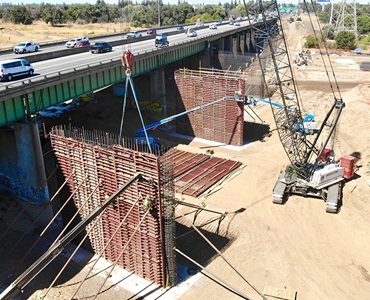
Construction Manager General Contractor (CMGC) is an alternative project delivery method that provides opportunity for Caltrans to leverage CMGC contractor experience by providing innovation and design input during the design phase of complex projects. Such input is not allowed under the traditional design-bid-build delivery method.
CMGC project delivery consists of a two-phase contracting method where the contractor provides preconstruction services and construction services.
In the first phase, Caltrans selects a contractor (the construction manager) based on qualifications. Typically, the construction manager is acquired when Caltrans design is approximately 30 percent complete. The construction manager provides preconstruction services early in the design phase, including input on design, scheduling, pricing, and phasing of the project.
During the design phase the project team tracks innovations, cost savings, and time savings. Innovations are ideas suggested by the construction manager and agreed to by Caltrans to implement in the project.
Having the contract manager as part of the project development team, especially during constructability reviews, is an effective tool in identifying and mitigating project risks prior to entering the construction phase of a project.
When the design is nearly 90 percent complete, Caltrans and the construction manager negotiate an Agreed-To-Price (ATP) for the construction of the project, or a portion thereof for the defined scope. Risks associated with the project are identified, assessed, and agreed to as part of the ATP.
If this price is acceptable to both parties, Caltrans executes a contract for construction services, and the construction manager becomes the general contractor; this is the second phase of the contracting method. If this price is not acceptable to both parties, the project will be advertised as design-bid-build and the CMGC contractor will not be allowed to bid on the project.
The CMGC project delivery method has the potential to provide preconstruction time savings to the project through standalone early work packages. An early work package accelerates the construction of the project because it is awarded for construction before the design of the entire project is completed.
Examples of an early work package are site preparation and early material acquisition/fabrication. Early work packages must be a severable phase of the construction, such that Caltrans is not obligated to have the construction manager construct any other portion of the project. Early work packages can expedite construction work on the critical path and shorten the construction duration, resulting in faster delivery.
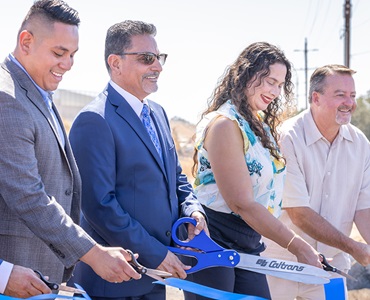
The CMGC Pilot Program was established in 2012 for Caltrans to use on six projects. Effective January 1, 2019, Caltrans was given permanent authority to utilize the CMGC project delivery method on projects with a construction cost greater than $10 million. Projects are approved for CMGC delivery by a Caltrans Alternative Contracting Steering Committee. The selection and approval are based on project complexity, size, location, scope, funding, opportunity for innovation, and amount of design completed.
To date Caltrans has 16 projects in construction that have utilized the CMGC delivery method. The construction manager innovations on these 16 projects total over $400 million, resulting in an overall average15 percent project savings. In addition, the CMGC delivery method has allowed projects to be awarded earlier, saving 105.3 months (nearly nine years) cumulatively on these initial 16 projects.
Caltrans has had many successes on our CMGC projects. The San Mateo 101 Managed Lanes project, completed in March, consisted of converting high-occupancy vehicle lanes to express lanes and adding an additional lane in each direction for a portion of the project limits. Caltrans and the contract manager worked together to condense the schedule with overlapping environmental and design phases allowing the first work package to open seven miles of express lanes in each direction three years early. Through the CMGC process the contract manager was able to contribute best practices and innovative ideas to the project. The contract manager provided input on how to save costs such as potential lane closure extensions increasing production rates and recycling road base on-site reducing off-hauling costs.
On the American River Bridge Rehabilitation project in Sacramento, still partially in the design phase, Caltrans worked closely with the contract manager to determine the methods of construction in the waterway. Collaborating with the contract manager resulted in the project permits being obtained a year earlier than originally anticipated. In addition, determining the methods of construction early in the process allowed Caltrans to identify materials needed for construction and awarded two early work packages acquiring these long lead materials.

The Cosumnes River Bridge (Sacramento County) Replacement project, for which a ribbon-cutting ceremony was held on Sept. 1, 2022, also had significant time savings. Awarding the work packages on this project a year early allowed for approximately half of the project to be constructed before the planned award date. By constructing the bridge in two phases instead of three, the CMGC process shortened the construction duration by one year. These time savings resulted in the project being completed two years early and providing earlier public benefits.
The contract manager was acquired early in the design process for the Interstate 80/Interstate 680/State Route 12 Interchange project, which was expected to be completed in late spring. This allowed Caltrans and the construction manager in the Solano County project to jointly develop and pursue innovative bridge design changes that saved the project time and money in construction in addition to awarding the project almost a year early. Innovations included changing bridge approach spans from precast girder structures to an on-grade roadway supported by a mechanically stabilized earth wall. Additionally, early joint field investigations were performed confirming that the bridge alignment could be shifted slightly to allow for the new bridge structure to be completed in a single phase rather than two.
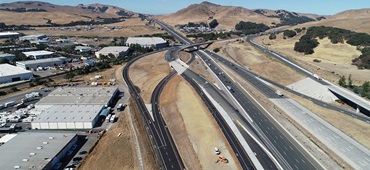
The Ventura Highway 1 Slope Restoration project (anticipated completion: spring of 2024) is located along the shoreline in an environmentally sensitive area. The CMGC process allowed the construction contractor to start work as soon as the contract is approved, saving months by not having to account for advertisement, award, and mobilization. Due to this CMGC efficiency the contractor was able to complete the first item of work within the environmental permit window, so the project was not delayed for an entire season.
The CMGC delivery method provides the opportunity for Caltrans to work collaboratively with the CMGC contractor to refine the project scope, optimize design, improve quality, manage costs, and share risks. With the benefit of this early collaboration, Caltrans has saved both time and money in the delivery of current CMGC projects.
Sources: Caltrans Office of Commercial Vehicle Operations, Division of Traffic Operations
![]()
Virtual vehicle-inspection pilot for transportation permits is delivering
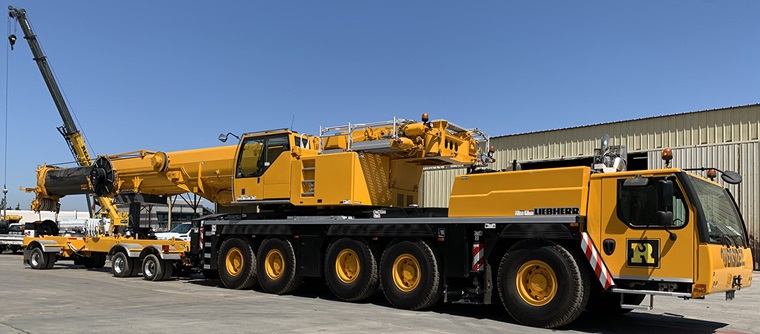
Caltrans reduces worker exposure and improves goods movement with system that skips in-person appointments
A pilot program that converted the in-person inspection process for certain commercial vehicle loads into a virtual one has proven a success, by saving time and money for Caltrans, reducing the exposure of our workers in the field, and expediting goods movement by streamlining what had been a cumbersome but critical obligation for transportation permit seekers.
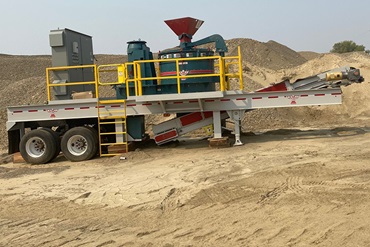
The pilot program was initiated by Caltrans Office of Commercial Vehicle Operations in January 2020. The timing proved to be fortuitous, with the emergence of COVID-19 forcing most state offices to limit in-person contact with the public only a few months after the virtual permit process began.
Owners of vehicles or ones that carry loads exceeding height and weight requirements for the stretch of roadway they plan on traveling must first obtain a transportation permit from Caltrans. Previously, Caltrans commercial vehicle inspectors traveled to designated locations throughout the state to visually review vehicles or loads, which involved recording vehicle dimensions and weight, logging data, verifying permit eligibility and compiling the information in a report.
Applicants for permits had to schedule appointments two weeks ahead of time of transport and bring the vehicle or the load in question to an inspection site.
To create a more efficient process for applicants and Caltrans, a virtual inspection system was devised and set up by the Office of Commercial Vehicle Operations team. Rather than securing in-person appointments, those seeking permits are now required to complete new online forms depending on the type of fixed load and vehicle, and submit supporting documents such as photos or diagrams. Inspectors review and verify that information and issue an inspection report.
The information in the inspection report is reviewed by the California Highway Patrol when permitted vehicles pass through Commercial Vehicle Enforcement Facilities (weigh stations) along the state highways. Misleading or erroneous information is subject to corrective actions.
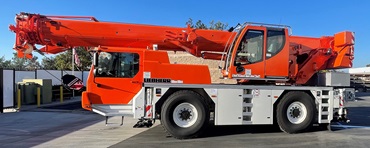
The streamlined virtual inspection process delivers numerous advantages for permit applicants and Caltrans, and fulfills the goals set out in the Caltrans 2020-2024 Strategic Plan.
Strengthen stewardship and drive efficiency – Securing a virtual inspection typically now takes less than a week, compared with the previous two-week window. In addition to being a time-saver, customers are spared the inconvenience of traveling to an inspection site ahead of their travel date to physically meet with inspectors.
Cultivate excellence – Prior to this process change, about 40 percent of a commercial vehicle inspector’s time was spent traveling. Switching to virtual inspections has eliminated this travel time, as well as employee expenses that included hotel, per diem, airfare when needed, and use of a state vehicle.
Safety first – With no physical interaction needed to complete inspections, Caltrans inspectors and applicants are not exposed to COVID-19 danger. Inspectors were able to adhere to state stay-at-home orders issued at the height of the pandemic while still maintaining the critical permitting function efficiently to help keep those traveling on our roadways safe.
Lead climate action – Eliminating the need for either party to travel to inspection appointments means fewer vehicle trips and less air pollution.
The number of commercial vehicle/load inspections performed by Caltrans rose from 468 in 2019 to 715 in 2022.
Sources: Caltrans Office of Commercial Vehicle Operations, Division of Traffic Operations
![]()

Caltrans Strategic Plan Performance Objectives
Caltrans 2020-2024 Strategic Plan has a series of performance objectives meant to gauge success at affecting the intended outcomes for each of the six goals. This dashboard represents those performance objectives that we are tracking and are able to report on.
Goal: Safety First
Reduce the number of on-the-job serious injuries to zero, annually.

An on-the-job serious injury is any work-related injury or illness resulting in a fatality, inpatient hospitalization, amputation, or loss of an eye. Work-related COVID-19 cases not counted in this performance objective. Annual traffic safety targets are presented as not-to-exceed targets. Data is provisional and subject to change. The traffic collision data used for these performance objectives will not be final until the third quarter of calendar year 2024.
Goal: Cultivate Excellence
Increase the percentage of surveyed external partners who positively respond to the statement, "Caltrans is a collaborative partner," to 83% by December 31, 2022.

Increase the percentage of surveyed Caltrans employees who "slightly agree," "agree," or "strongly agree" with the statement, "I would recommend Caltrans as a great place to work to members of my community," to 88% by December 31, 2022.

Goal: Strengthen Stewardship and Drive Efficiency
Increase the utilization of DBE certified contractors, overall and across each SED group, to annually achieve our DBE goal of 22.2%.

Increase the dollar value of small businesses, disabled veteran business enterprises, and disadvantaged business enterprises, by 100% by June 2023.

Caltrans Office of Civil Rights (OCR) projected year-over-year increases based on increases from the baseline fiscal year of 2014-15. Given the office’s virtual outreach, increase in certification, and other tools used in its outreach.
Goal: Lead Climate Action
Increase the percentage of Caltrans fleet that are ZEVs, to 8% by June 2023.

Zero-emission vehicles include pure zero emission vehicles such as hydrogen fuel cell vehicles (FCVs) and battery electric vehicles (BEV). Plug-in hybrid electric vehicles (PHEVs) are considered transitional ZEVs and are included in the department’s count of ZEVs. The percentage of ZEV vehicles in the fleet is calculated using the total number of ZEV fleet in-service count divided by the total self-propelled mobile fleet in-service count. The department faces a few challenges to meet the goal of 20% ZEVs by 2025. These challenges include vehicle technology and availability, fueling and charging infrastructure, and funding. In the near term, the fleet ZEVs are not anticipated to increase as fast as in future years when the industry and the department start to overcome these challenges.
Goal: Advance Equity and Livability in all Communities
Develop Equity Index (1.0) to identify underserved communities for investments and projects, and measure equity broadly across Caltrans programs by June 30, 2022.

Create an accessibility score by March 2022.

The Accessibility Score will rate the accessibility to public and active transportation travel options, proximity of affordable housing to employment and civic centers, and a high-quality public realm. Accessibility evaluation tool(s) will be identified to determine a project or plan’s accessibility score.
Implement use of an engagement tool to assess baseline engagement and enable documentation of engagement efforts by June 2024.


